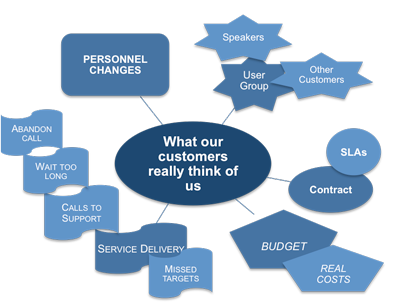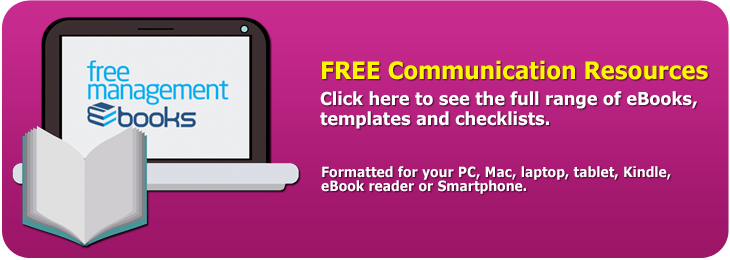Communication Skills - Preparing the Main Body
The first stage is to prepare the main body of the presentation because all of the other stages are dependent on it. The most common problem that people have when developing a presentation is to underestimate how long it is going to take to deliver.
The ideal speed for a presenter is about 100 words per minute.
This means that if you have 15 minutes available for the main body, then you can comfortably deliver about 1,500 words. If you have five key points then you could allocate 300 words to each one.
However, this takes no account of the need for transitions or the fact that you may need to explain something further because you are getting blank looks from the audience. In reality, 200 words would be the limit for each of the five points and you cannot say much in 200 words.
An alternative approach for a 15-minute main body would be to cut the number of key points down to three, as this would allow you about 400 words for each one and would also mean that there are fewer transitions. Both of these factors would almost certainly result in a more powerful and memorable presentation.
Trying to cram too much in is the number one cause of failure for business presentations. The result is invariably a weak presentation that fails to get the message across because of insufficient repetition, poor transitions from one topic to another, and a rushed conclusion. It is also stressful for you as a presenter to realize that you have too much material for the time available. The later you realize this, the worse it is because it means that the other areas of your presentation - the introduction, summary, conclusion, and any visual aids and handouts you may have already prepared - will be compromised.
The most important thing to remember when you are working through this stage is that getting rid of unnecessary material is the best use of your time and will lead to a clear and concise presentation that is relatively stress free to deliver. Be ruthless and get rid of anything that is not absolutely necessary. In the unlikely event that your presentation is going to be too short, you can always add it back in later with minimal effort.
 |
This mind map shows your final five key points and the updated key message statement for the executive. Your next action is to decide the priority of these five points and what facts you will include for each point. There will be several facts and figures for each key point: your task is to decide which are the most important.
This process is an iterative one - you will work through each key point several times before you arrive at the final information and wording for each one. You may find yourself refining the number of key points in the presentation as you reassess each one in the light of the key message statement. This may occur for several reasons:
• The time slot is too short
• A key point argument is too emotive or subjective
• One or two points are no longer as 'key' as those you retain
• The concept of a key issue is too complex
• The data for a key point is insufficient or weak so has to be excluded.
A significant part of your work in this stage is to come up with transitions between each of your key points. These are important as these regular reminders of what you have just said and whereabouts you are in the overall structure are absolutely crucial for keeping the audience with you. The audience cannot be relied on to remember the overall structure of your presentation, nor can they be relied on to have followed any detailed arguments.
Transitions also enable you to offer segments of your audience more depth in a key point without the risk of losing the remainder. As you sum up what you have said on a key point in language you're confident that everyone will understand you will bring everyone back on board with your road map. For example you could say:
'Having just explained… (summarize). We now need to look at … (introduce next point)'
In the example, the outline scope shown in the mind map resulted in you having five key points:
➢ Personnel changes
➢ User Group
➢ Contract
➢ Budget
➢ Service Delivery
Now you need to add information to each of these points and then assess how well that information supports your key message statement. This stage is by far the most time consuming of the five stages and requires the most mental effort.
However, it is the most important stage because no one will take your key message statement seriously unless you present compelling evidence to support it. As you work through the evidence you have, you may find that it changes the emphasis of the key message statement. Many of the presentations that you give will evolve in this way because the act of assembling, sifting, and organizing facts can make you see things in a new light or realize that the evidence does not support your preconceptions.
Your next action is to decide the order of these key points and then find the right words to explain each message in a way that gets them across to the audience. There is no shortcut that you can apply to this step. You need to write the content of each key point out in full using a word processor or dictation software, editing as you go.
This process is essential if the structure of your final presentation is going to be clear and logical because:
- You can keep track of everything better when it is on paper than when you're just thinking about it.
- You can keep going back to cross-check the content against your key message statement.
- Writing things down makes it easier to check logic and objectivity.
- Writing everything down will force you to decide on the best order for the material.
- You can see where repetition is necessary and where it is harmful to your argument.
- You will be able to shape the overall flow and give everything the right amount of emphasis.
- The end result forms the basis of your presentation handout, which can be used in the event of cancellation or given to non-attendees.
The Appendix in the eBook 'Preparing a Presentation' illustrates how evaluating the evidence from the customer satisfaction survey and using the associated mind map can change preconceptions about how many key points need to be included in the presentation and how they are made up. This is a very detailed study and is included to show how this process evolves using a realistic example.
You may also be interested in:
Preparing a Management Presentation | Repetition and Timing | Your Presentation Aim | The Five-Stage Format | Key Point Guidelines | Finalizing the Main Body | Preparing Your Pre-Introduction | Preparing the Introduction | Preparing the Summary and Conclusion.



